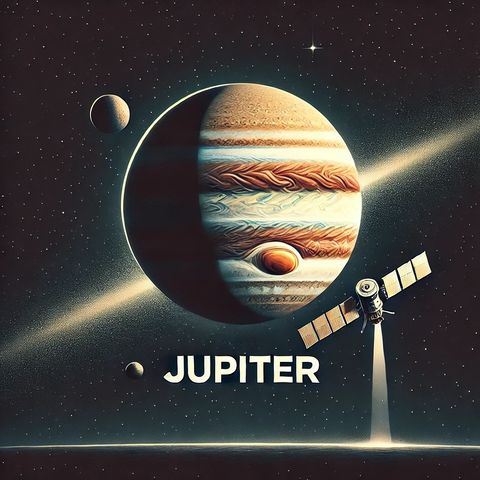Planet Jupiter Destiny of a Cosmic Monarch

Scarica e ascolta ovunque
Scarica i tuoi episodi preferiti e goditi l'ascolto, ovunque tu sia! Iscriviti o accedi ora per ascoltare offline.
Descrizione
Jupiter is the largest planet in our solar system and is known for its distinctive features and fascinating characteristics. Here’s an overview of what makes Jupiter so unique:Basic Characteristics -...
mostra di più- Size: Jupiter has a diameter of about 142,984 kilometers (88,846 miles), making it more than 11 times the diameter of Earth. It is so massive that it could fit all the other planets in the solar system inside it.
- Mass: It has a mass of 1.898 × 10^27 kilograms, which is approximately 318 times the mass of Earth.
- Orbit and Rotation: Jupiter orbits the Sun at an average distance of 778 million kilometers (484 million miles). It takes about 12 Earth years to complete one orbit around the Sun. However, a day on Jupiter (one full rotation) is only about 10 hours long, making it the fastest rotating planet in the solar system.
- Atmosphere: Jupiter’s atmosphere is composed primarily of hydrogen (about 90%) and helium (about 10%), with trace amounts of other gases such as methane, ammonia, and water vapor. The atmosphere features multicolored bands, created by strong winds and chemical reactions at different altitudes.
- Great Red Spot: One of Jupiter's most famous features is the Great Red Spot, a gigantic storm that has been raging for at least 400 years. This anticyclonic storm is larger than Earth and is characterized by its reddish hue, which is still not fully understood.
- Magnetic Field: Jupiter has a powerful magnetic field, about 20,000 times stronger than Earth’s. This magnetic field creates intense radiation belts and influences the planet’s many moons.
- Moons: Jupiter has at least 79 known moons, with the four largest being the Galilean moons: Io, Europa, Ganymede, and Callisto. These moons are some of the most interesting objects in the solar system, with features such as active volcanism (Io), subsurface oceans (Europa), and diverse geological landscapes (Ganymede and Callisto).
- Space Missions:
- Pioneer 10 and Pioneer 11 were the first spacecraft to visit Jupiter in the early 1970s.
- Voyager 1 and Voyager 2 provided detailed images and data about the planet and its moons in 1979.
- Galileo orbited Jupiter from 1995 to 2003, offering extensive data on the planet and its moons.
- Juno, launched in 2011, is currently in orbit around Jupiter, studying its atmosphere, magnetic field, and internal structure.
- Radiation Belts: Jupiter's intense magnetic field creates radiation belts that are so powerful they can damage spacecraft electronics.
- Ring System: While not as prominent as Saturn's, Jupiter has a faint ring system composed mainly of dust particles ejected from its moons.
- Auroras: Jupiter’s poles exhibit spectacular auroras, caused by interactions between the planet’s magnetic field and charged particles from the solar wind.
Informazioni
| Autore | QP-4 |
| Organizzazione | William Corbin |
| Sito | - |
| Tag |
Copyright 2024 - Spreaker Inc. an iHeartMedia Company
